Criminals of the Victorian Era
Publié le 02/03/2025
Extrait du document
«
Ameila Dyer is undeniably one of Victorian England’s most notorious killers, probably
second only to Jack the Ripper.
As a criminal, her crime was murder, but the worst part is, her
victims were babies.
Called the “Angel Maker”, she is thought to have killed around 400
babies in a thirty-year span, in which she was able to conduct her crimes with apparent
impunity.
She began her criminal career in Bristol in the late 1860s, by opening a house of
confinement where she took in unmarried and pregnant girls who had nowhere else to go.
She
would then frequently smother their baby at birth, but often much to the relief of the mother.
Those crimes went unchallenged since Victorian doctors couldn’t tell the difference between
suffocation and still-birth.
She later moved to Reading and set herself up as a “baby farmer”,
taking in children from desperate mothers who couldn’t keep them no more, and promising that
she would find them a better life.
The monster would take the money before actually strangling
the helpless children with dressmaking tape, and dumping their corpses in the river Thames.
Dyer was finally arrested after the discovery of the body of an infant in the reeds of the Thames
since her address was on the parcel paper.
Afterwards, a search of the Thames was ordered and,
after 50 bodies discovered, she admitted to the police with this blood running cold quote:
“You’ll know all mine by the tape around their necks”.
Her case was so terrifying and famous
that songs were written about her, and Britain’s adoption and child protection laws had to be
toughened up in a response to the public outcry.
Dyer was eventually hanged at Newgate Gaol,
near the Old Bailey in London, in 1896.
She was 58.
William Palmer was convicted of murder by poison in one of the most famous cases of the
1800.
Indeed, after completing his medical training, he returned to his hometown of Rugeley to
practice as a doctor.
Shortly after his wedding with Ann Thornton in 1847 and the birth of his
first child, William Brookes Palmer, in either 1848 or 1850, a lot of individuals surrounding Dr.
Palmer died, often in his presence or after being in his company.
These included his next four
children, who died either 7 hours, three days, one month, or two months and a half after their
birth.
They also included his mother-in-law, his wife, his brother, his uncle, individuals to
whom he owed money, as well as several illegitimate children of his.
For those deaths, he had
never been suspected, although the death of his brother had been investigated, but Palmer’s
involvement couldn’t be proven.
His wife, Ann, was believed to have died of cholera since, in
1853-1854, the so-called third cholera pandemic was affecting Great Britain.
Palmer thus did
benefit financially from the death of his wife because he had taken out a 13.000£ insurance
policy on her life, but he was still not suspected at all.
He finally found himself in trouble after
the suspicious death of a gambling buddy who fell ill right after betting on horses with Palmer,
winning a large sum of money, unlike the doctor, and dinning with him.
The man was called
John Parsons Cook and, after his tragic death, Palmer was the one who collected his gambling
money and then used to pay off his own debts.
A post mortem of the body revealed that Cook
had been poisoned and the final straw was Palmer’s purchase of strychnine shortly before
Cook’s death.
The doctor was arrested and convicted, largely on circumstantial evidence.
The
bodies of Ann and Walter Palmer were then also re-examined, but not enough evidence was
found to charge Palmer with their deaths, although it is believed today that he was the one who
did it.
An Act of Parliament was passed to allow the trial to be held at The Old Bailey in
London, as it was felt that a fair jury could not be found in Staffordshire.
Despite the evidence
being circumstantial, the similarity between Cook’s death and the other strychnine victims was
enough for the jury to find Palmer guilty of murder.
He was called ‘Palmer the Poisoner” and
executed in front of a 30,000 member crowd in June of 1856.
The reason why his trial made
headlines is because it was the very first to be moved away from an outlying jurisdiction
because of fears that Palmer would not receive a fair trial.
Dr.
William Palmer’s case was such a
sensation that it, and its characters, inspired two of the greatest writers of the time.
Indeed,
Palmer is mentioned in Sir Arthur Conan Doyle’s “The Adventure of the Speckled Band”,
which is one of the many stories of Sherlock Holmes, and Sir Frederick Field, who is the
policeman who investigated Palmer’s brother death, was the inspiration for Inspector Bucket in
Charles Dickens’ “Bleak House”.
We all know that, at the end of the 19th century, everyone could feel England’s power just by
walking a day in London.
From Westminster where the Houses....
»
↓↓↓ APERÇU DU DOCUMENT ↓↓↓
Liens utiles
- Hanif Kureishi - The Buddha of Suburbia
- does the end justifies the means
- the handmaid's tale: How far do you agree that Margaret Atwood makes resistance central to THT?
- La surprise au cinéma - Critique The King of Staten Island et Annette
- The danger of space exploration on the human body and the environment


